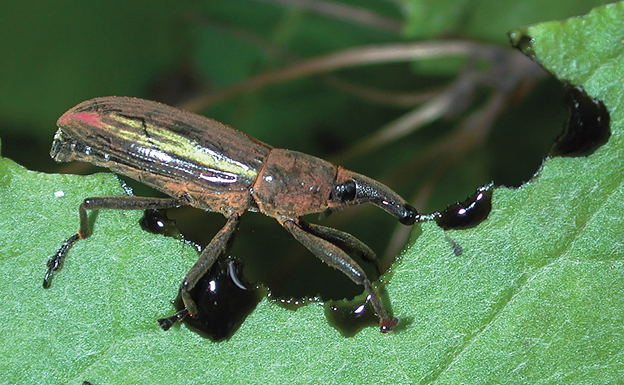 Evolution & Behaviour
Evolution & Behaviour
Beetles became an evolutionary success with help from stolen microbial genes
How did beetles become one of the most diverse groups of animals? We reconstructed the beetle family tree and studied beetle DNA. We determined that plant-feeding beetles rapidly diversified after ”stealing” microbial genes, which facilitated digestion of plant tissues. We propose that these genes were key to the evolutionary success of beetles.

There are more than 400,000 known beetle species - and perhaps one million more species left to discover. This makes beetles one of the most diverse groups of animals on Earth. However, the causes for their extraordinary diversity are widely debated. Many claim that herbivory (plant-eating) and the diversification of flowering plants (an important food source for beetles) played an important role in their evolutionary success. However, recent studies have failed to find a consistent link between feeding on flowering plants and beetle diversification, suggesting there may be more to this story.
Plant cell walls -; a major component of plants - comprise Earth's most abundant reservoir of carbohydrates. Animals typically require partnerships with symbiotic microbes to digest the complex molecules in plant cell walls. However, some herbivorous beetles make their own enzymes capable of digesting plant cell walls. We proposed that the ability to make these enzymes made beetles more efficient herbivores, and that this played an important role in beetle diversification.
To evaluate this theory, we used DNA sequences from beetle genomes and information from the beetle fossil record to reconstruct the beetle family tree, including timing and patterns of beetle diversification. Then, we used these data to estimate rates of diversification for different groups of species in the beetle family tree with different feeding habits, such as herbivory, or predation. Increases in diversification rate are notable because they typically reflect the formation of new species in response to ecological opportunity or evolutionary innovation.
We determined that the origin of beetles was more than 300 million years ago, in the Carboniferous Period, approximately 100 million years before the earliest known dinosaurs. Some beetle groups appear to have diversified in tandem with flowering plants, but many did so somewhat later, during the Cretaceous Period, when flowering plants rose to ecological dominance. Notably, we also found an association between high beetle diversification rates and shifts to specialized herbivory, including wood-boring and leaf-mining. We identified large concentrations of genes encoding plant cell wall digesting enzymes in genomes from the two most species-rich groups of herbivorous beetles. These distant-relatives, separated by more than 250 million years of evolution, appear to have independently obtained their genes for plant cell wall digestion from microbes (bacteria and fungi), through a process called horizontal gene transfer.
Several groups of microbes proposed as original donors of these beetle genes are found in leaf litter and soil (important habitats for beetles) or are known symbionts in the digestive tract of beetles. Such intimate interactions may increase the likelihood of horizontal gene transfer taking place. Moreover, we showed that these genes appeared in beetle genomes at the same time that herbivorous beetles experienced increases in diversification rate. This suggests that the metabolic innovations these genes conveyed to beetles were highly advantageous, and may have facilitated the rapid diversification of herbivorous beetles.
We propose that plant cell wall digesting enzymes enabled more efficient digestion of plant tissues, and without the requirement of forging specialized relationships with symbionts. With this novel ability, beetles could develop new and highly specialized plant-feeding habits, ultimately resulting in the large number of herbivorous beetle species alive today. Our results may help explain why some groups of herbivorous beetles are not very diverse: beetles that lacked a diverse repertoire of plant cell wall digesting enzymes thus lacked the metabolic advantage that allowed their relatives to diversify.
Our results show that the extraordinary diversity of beetles likely resulted from a combination of factors, notably including diversification in tandem with flowering plants as these became dominant and diverse, and rapid diversification after "stealing" (effectively, domesticating) microbial genes, which provided a huge advantage by facilitating specialized herbvivory without the need for symbiotic microbial partners.
Original Article:
1. McKenna DD, Shin S, Ahrens D, et al. The evolution and genomic basis of beetle diversity. Proc Natl Acad Sci U S A. 2019;116(49):24729-24737.
Next read: How did wild cats turn into our beloved domestic animals? by Magdalena Krajcarz , Maciej Krajcarz
Edited by:
Dr. Ayala Sela , Associate Editor
We thought you might like
How humans gave acne to the grapevine
Feb 28, 2015 in Evolution & Behaviour | 3.5 min read by Carlos J. Rivera-RiveraThe lingering effects of parental care and its role in evolutionary change
Jan 27, 2016 in Evolution & Behaviour | 4 min read by Rebecca KilnerLiving without mitochondria: the downfall of one textbook truth
Oct 3, 2016 in Evolution & Behaviour | 3.5 min read by Lukáš NovákFancy footwork: Darwin’s pigeons and the evolution of foot feathers
Jan 20, 2017 in Evolution & Behaviour | 3.5 min read by Eric DomyanMore from Evolution & Behaviour
Cicada emergence alters forest food webs
Jan 31, 2025 in Evolution & Behaviour | 3.5 min read by Martha Weiss , John LillSize does not matter: direct estimations of mutation rates in baleen whales
Jan 29, 2025 in Evolution & Behaviour | 4 min read by Marcos Suárez-MenéndezThe Claws and the Spear: New Evidence of Neanderthal-Cave Lion Interactions
Jan 22, 2025 in Evolution & Behaviour | 3.5 min read by Gabriele RussoA deep-sea spa: the key to the pearl octopus’ success
Jan 20, 2025 in Evolution & Behaviour | 3.5 min read by Jim BarryFeisty fish and birds with attitude: Why does evolution not lead to identical individuals?
Aug 31, 2024 in Evolution & Behaviour | 3 min read by Lukas Eigentler , Klaus Reinhold , David KikuchiEditor's picks
Trending now
Popular topics


